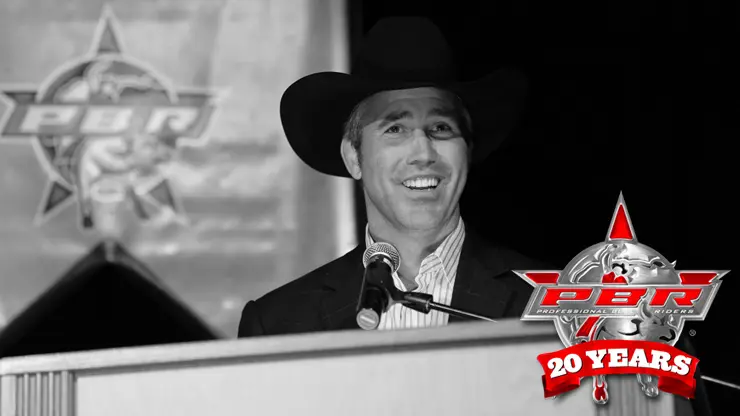
FORT WORTH, Texas ― When Randy Bernard accepted the job as the Chief Executive Officer of the PBR he readily admits he had no idea what he was getting himself into.
In fact, the California native never even saw the organization's financial statements until he was already on the job and when he did finally go through them, he couldn't believe what he saw. They had $8,000 in the bank and $140,000 worth of expenses yet to be paid.
To know Bernard as a businessman is to know that even today ― nearly 20 years later ― it's only expected of him to understate the task at hand. "It was a pretty big hurdle at the time," he said, with a smile in the documentary film "This Is Not Rodeo!"
The 2009 film chronicled the formation of the PBR, including Bernard's early years and the sport's meteoric rise as the self-proclaimed "fastest growing sport in the world."
"One thing you really need to try and do is make sure we make $50,000, so you can get paid."
Throughout its 20th anniversary season, the PBR will profile the Top 20 Moments in PBR History. "A Man with a Plan" is the latest in an ongoing series of moments.
That man is, of course, Bernard.
Bernard was hired following the conclusion of the organization's first World Finals and the company was in such dire financial straits that co-founder Cody Lambert may have been smiling when he told the new CEO "one thing you really need to try and do is make sure we make $50,000, so you can get paid," but he wasn't kidding.
The young executive set up a tiny office in downtown Colorado Springs, Colo., with little more than a folding chair, card table and a phone line and, as Bernard recalled in the film, "I learned everything from rolling up the sleeves and jumping in."
"The day we hired Randy I knew we had the right guy," said Ty Murray, nine-time World Champion and one-time President of the PBR.
He may have been the right man at the right time, but he certainly had a long way to go.
His first board meeting is, perhaps, the most infamous board meeting in PBR history.
The meeting has been retold in both the film, which was produced by Joe Loverro, and the 2006 Josh Peters book "Fried Twinkies, Buckle Bunnies & Bull Riders: A Year Inside the Professional Bull Riders Tour." Lambert and fellow co-founder Tuff Hedeman were arguing when Lambert threw a chair across the table nearly hitting Bernard and puncturing a hole in the wall behind him.
"I'll never forget the look on Randy's face," said Murray, in the documentary film, that premiered during the 2009 World Finals, "at that moment I knew he was thinking, 'What in the hell did I get myself into?'"
Bernard joked that in the early years it wasn't necessarily about the best ideas, but who yelled the loudest.
However, it was about having good ideas and, truth be told, Bernard has the best ones.
In his first year, Pro Bull Rider magazine was launched and the World Finals was extended from one to three days. A year later, the Touring Pro Division was launched and the total purse awarded at the World Finals equaled $1 million.
In 1999, the World Finals was moved to the Thomas & Mack Center, where it remains today, and is extended to include a fourth day with a total payout exceeding $1.5 million.
In 2001, with the help of Tom Teague, Bernard executed what he's referred to as his most important decision, which was for the PBR to buy back its television rights. That same year the PBR appeared on network television ― NBC ― for the first time in its history.

Click here to view more photos of
Randy Bernard.
The controversial move paid off and the program received a 2.3 rating, which was double what the initial projections had been.
In 2003, the Bud Light Cup Series is renamed the Built Ford Tough Series and the $1 million bonus is awarded to the World Champion courtesy of Ford Trucks.
A year later the World Finals expanded yet again and became a two-weekend, eight-round event and the PBR assisted in forming the American Bucking Bull, Inc., and there were countless other accomplishments and decisions Bernard made.
He was instrumental, in 2006, signing entertainer Flint Rasmussen to an exclusive five-year contract with the PBR and, in 2007, he took the BFTS to Madison Square Garden for the first of what has now been seven consecutive seasons.
That year he spearheaded the move from an overcrowded headquarters in Colorado Springs to its own state of the art facility in nearby Pueblo, Colo., and, more importantly, the purchase of majority shares by New York-based investment group Spire Capital.
Bernard's swansong, if you will, was in 2010 when he orchestrated the first Iron Cowboy Invitational in Arlington, Texas, at Cowboys Stadium.
Murray has repeatedly referred to Bernard's time with the PBR as "magical."
Bernard left two months into the 2010 season to take the same role with IndyCar and recently was named CEO of RFD-TV.
"I saw so much potential," said Bernard, in the film "This Is Not a Rodeo!"
Born in Paso Robles, Calif., Bernard worked for the California Mid-State Fair when he first met Lambert and Murray, who he hired to make a special appearance at a small rodeo hosted by the annual fair. He had no idea that years later the two instrumental founders would ask him if he would be interested in running the PBR.
But Bernard was a risk taker and that was always the common bond he shared with bull riders: he believed in himself.
He also believed in the PBR.
"I loved the opportunity," Bernard said. "I had a passion for it after just going to a couple of the events."
Follow Keith Ryan Cartwright on Twitter @PBR_KRC.